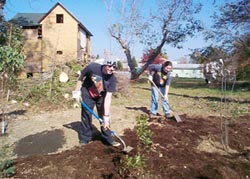 Aid to Retarded Citizens Plants a Millennial Garden
Aid to Retarded Citizens Plants a Millennial Garden Aid to Retarded Citizens Plants a Millennial Garden
Aid to Retarded Citizens Plants a Millennial Garden
by Christy Grimes
photo by Christy Grimes St. John's students Dave Prosper and Sonia Wisniewski volunteer for planting day at ARC's Spa Road location.
A squat cube cocked at an angle to Spa Road and facing the city recycling center, Aid to Retarded Citizens of Annapolis, is a humble facility with grandiose plans for the third millennium of our era. No, not a year-end blowout. Rather something to flourish in the century to come: the ARC Marylandscapes' sensory garden.
"The whole idea is to include plants of all different textures, colors, fragrances, with nice wind and water effects. All things to excite the senses," says ARC volunteer Mel Wilkins, who designed the garden.
It started out simple enough. As ARC director Kate Rollason recalls: "M.L. Dodge - an ARC staffer - came back from a Maryland School for the Blind workshop saying, 'here's a great way for everybody to experience a garden: attract butterflies and make scents and noises.' Then Mel Wilkins came along and turned it into a real park."
A park with 27 themed mini gardens. These include a butterfly station, wetland pond garden with a water cascade, something called Hummingbird Heaven, plus a 50-black-eyed Susan salute to Maryland. Wide, wheel-chair accessible brick walkways will thread the gardens, with benches, statues and even a gazebo.
"My daughter, ARC staffer Laura Wilkins, called me and said, 'Want to help ARC design a garden?' I said: 'sure,' Wilkins recalls. "I guess my type A personality came out. Before you know it, we had a 27-plan garden."
When planting began the first Saturday of November, the denuded ARC property looked more like the surface of Mars than the wonderland it promises to become.
"You just have to visualize the ultimate design," says native plant specialist Hollie Munsel, a master gardener who advised ARC on what to plant and where to put it. "By next year, this garden will look a lot different. But it takes a few years for gardens to mature."
Tool-wielding volunteers from St. John's, the Naval Academy and around town stripped turf, dug holes for saplings and bushes, hoed rows for bulbs and spread mulch. Standing next to a big pile of dirt, with bricks for new walkways scattered at her feet, director Rollason described her role. "I just help Mel. I've worked for him some Saturdays. Today I swung a pickax, which I've never done. It scared a lot of people," she shrugged. "I don't see why. We had a load of rocks and we needed some gravel."
As Marylandscapers, the ARC crew must enact their garden fantasies with only native area plants.
"It's better for wildlife and for the environment," says Munsel. "Native plants don't need much water, fertilizer or pruning. Hopefully this will inspire other people to plant gardens like this in their own yards."
For Wilkins, it was an initiation. "I'm just a home gardener," he says. "I'm used to going to a nursery and buying something in a pot from China or Japan. I learned a lot. I didn't realize what kind of trees and shrubs we had in Maryland you could use in a garden."
Plants like red chokeberry, black haw and naked witherod for the Fall Brilliance garden. Tickseed and Joe Pye weed will lure butterflies to the Butterfly Station.
"To attract the zebra swallowtail, we'll also have a paw paw tree,
its sole food," says Munsel. "And in the berry patch will go raspberries,
elderberries and high and low blueberry bushes."
"We've also been able to substitute a lot of native plants for popular exotics," Munsel adds, pointing to the ARC building. "Those are inkberry bushes against the foundation. "They're a good substitute for boxwood, which is what most people plant along their walls. Inkberrys don't grow much over four feet, they don't need pruning, and they're evergreen."
photo by Christy Grimes Louise Hayman, at podium, prepares to hand out $100,000 in MaryLandscape grants. At left is Chesapeake Bay Trust director David Minges; at right Kate Rollason, director of ARC of Anne Arundel County, and Christine Duray, of Maryland 2000.
ARC's neighbor to the west, Annapolis' bus depot on Chinquapin Round Road, is another Marylandscape beneficiary with its own millennial legacy to bequeath.
"We plan to reintroduce the native Chinquapin chestnut to the road for which it was named, but on which it's no longer found," says Danielle Matland, city transportation director.
Staffer Paul Foer found Chinquapin cuttings at a rural Virginia nursery. "This species grows well in barren places. We hope to propagate them at our bus stops and along the stretch of road fronting our facility," Foer says.
This garden will do more than restore the Chinquapin, he adds. "Our depot and maintenance facility is on one of the ugliest streets in Annapolis. In fact, it's a former waste facility. The essence of our program is to improve neglected urban environments like this."
A Marylandscape garden must endure at least ten years. "That's one of the challenges," laughs sensory gardener Wilkins. "Everybody likes to plant gardens and see flowers, but not everybody wants to pull weeds and mulch."
Prove Wilkins wrong: pull out your tools, put on your canvas gloves and mosey over ARC Sat. Nov. 20 (see "Good Bay Times") to make your own mark for posterity. "Or you can sponsor a brick or two for us," says Rollason of ARC.
| Issue 45 |
Volume VII Number 45
November 11-17, 1999
New Bay Times
| Homepage |
| Back to Archives |